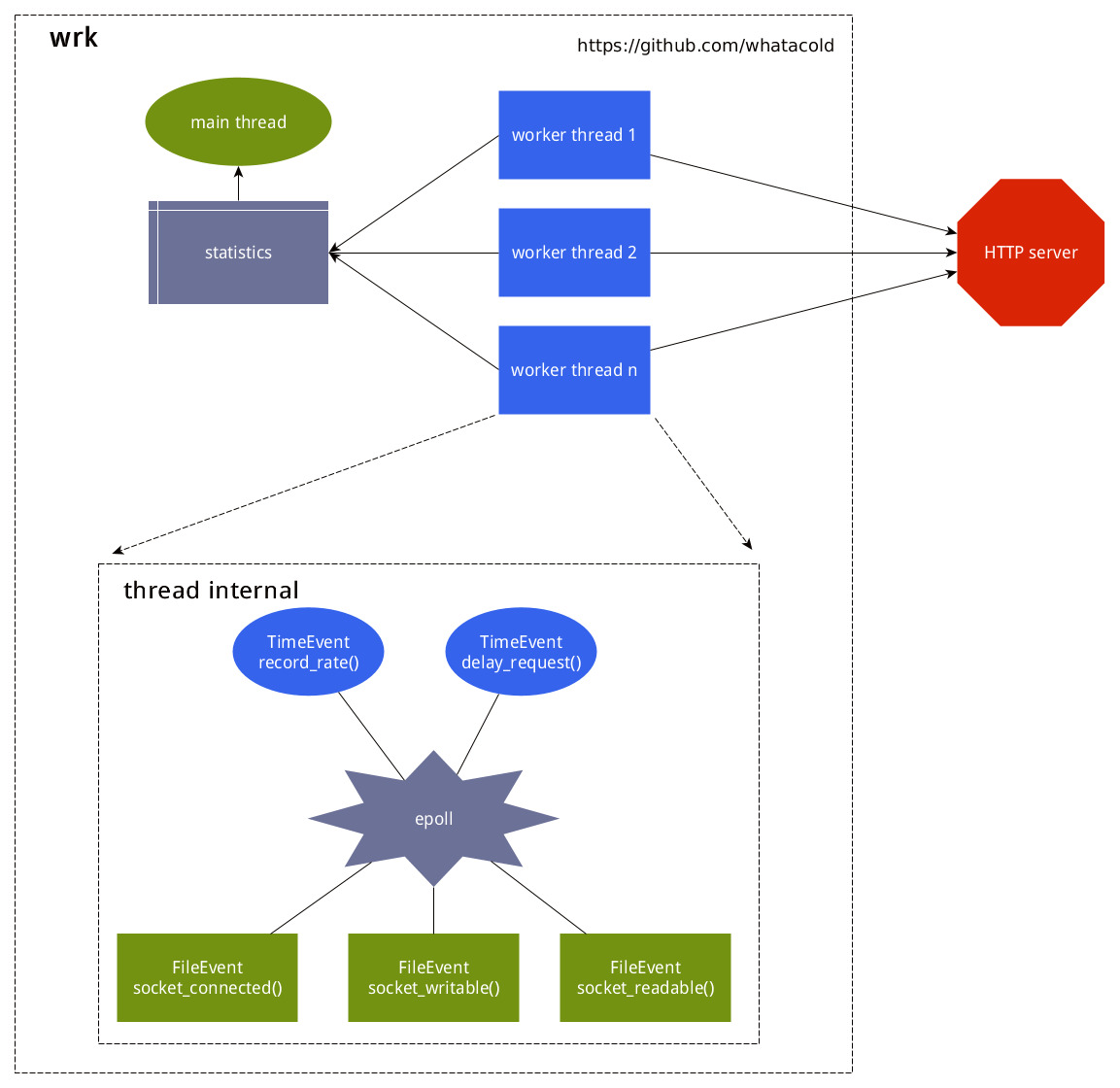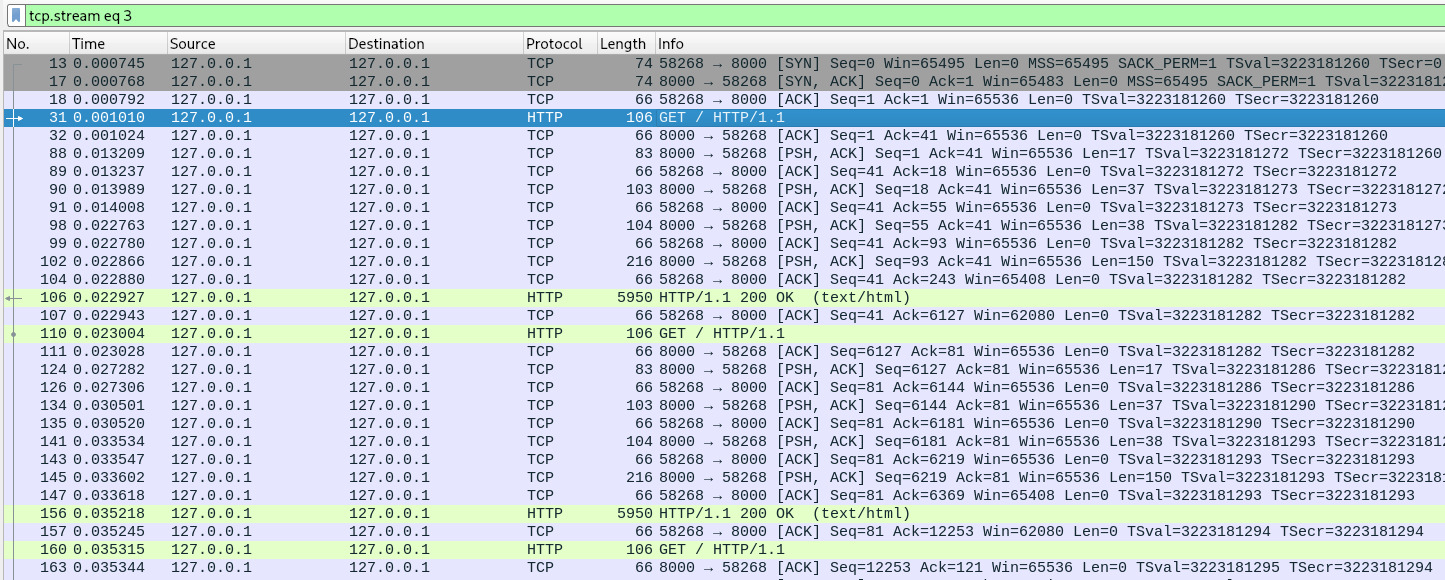注:本文分析的是 wrk v4.1.0 的源码。
wrk 是一个用 C 实现的 HTTP 压测工具,所有的参数都是通过命令行传递,没有配置文件,很容易使用;编译产物只有一个二进制文件,部署简单。
它的运行参数只有几个:
$ ./wrk
Usage: wrk <options> <url>
Options:
-c, --connections <N> Connections to keep open
-d, --duration <T> Duration of test
-t, --threads <N> Number of threads to use
-s, --script <S> Load Lua script file
-H, --header <H> Add header to request
--latency Print latency statistics
--timeout <T> Socket/request timeout
-v, --version Print version details
Numeric arguments may include a SI unit (1k, 1M, 1G)
Time arguments may include a time unit (2s, 2m, 2h)另一方面, wrk 还支持通过 LuaJit 来定制每个测试用例,这点比 ab 强大。
与 Apache JMeter 大而全的功能相比, wrk 的统计数据简单了点,只有 Latency 和 QPS 两项(其中的 Stdev 是 standard deviation 的简写,即标准方差),也无法按照时间的推进看到整个曲线。
一次 wrk 运行的效果如下:
./wrk -t 2 -d 10s http://localhost:8000
Running 10s test @ http://localhost:8000
2 threads and 10 connections
Thread Stats Avg Stdev Max +/- Stdev
Latency 24.86ms 17.36ms 72.64ms 60.35%
Req/Sec 207.41 21.92 262.00 70.00%
4135 requests in 10.01s, 20.49MB read
Requests/sec: 413.02
Transfer/sec: 2.05MB了解了 wrk 的基本使用之后,接下来我们来看一下 wrk 内部的实现原理。
wrk 内部采用多线程结合IO多路复用的模型,整体如下。

首先,每个线程有一个 epoll 来处理非阻塞的网络事件,主要有以下几个函数来负责处理:
- connect_socket
- socket_connected
- socket_readable
- socket_writable
其中 connect_socket 这个函数需要特别注意,它的功能是连接 HTTP 服务器。但它有一个问题,那就是在 thread_main 线程入口中把当前线程的所有连接都一次性创建好,多个压测请求会复用同一个 TCP 连接。
thread_main 相关代码片段如下:
for (uint64_t i = 0; i < thread->connections; i++, c++) {
c->thread = thread;
c->ssl = cfg.ctx ? SSL_new(cfg.ctx) : NULL;
c->request = request;
c->length = length;
c->delayed = cfg.delay;
connect_socket(thread, c);
}通过 tcpdump 抓包并使用 Wireshark 查看,也能确认这两点。


除了网络相关操作外,每个线程还有一个定时器( record_rate() 函数)用于把自己的数据记录到全局的统计数据中( stats_record() 函数)。
统计数据结构基于数组的哈希表来设计,数组的下标为统计指标数值,值为它出现的次数。
相关结构体定义:
static struct {
stats *latency;
stats *requests;
} statistics;
typedef struct {
uint64_t count; // data 中被使用的
uint64_t limit;
uint64_t min;
uint64_t max;
uint64_t data[]; // 元素个数是 limit
} stats;比如当 data 用于表示 QPS 时,其中的数据是:
index(QPS): 0 1 2 3 4 5
value(count): | 0 | 12 | 44 | 90 | 29 | 42 |
那么平均 QPS 就是 (1*12+2*44+3*90+4*29+5*42)/(12+44+90+29+42)=3.21
由于整个程序是多线程的,而 statistics 又是全局变量,因此需要有顺序更新机制来保证多线程的顺序访问。这里 wrk 采用 CAS 方式,而不是直接用锁,粒度更细:
__sync_fetch_and_add增加对应下标的计数;__sync_val_compare_and_swap更细当前下标的 min max 边界,如果由于并发导致更新失败,会一直尝试直到成功;
总的来说, wrk 代码写得不错,简洁易读。功能上, wrk 具有简单易用等优点,但同时也要注意,它的所有连接都是在启动时建立的,压测的 HTTP 请求会复用 TCP 连接,与真实的用户场景可能不一样;另外它的统计数据也比较简单,缺少时间维度,这样就绘制不了按时间推移的曲线,不直观。